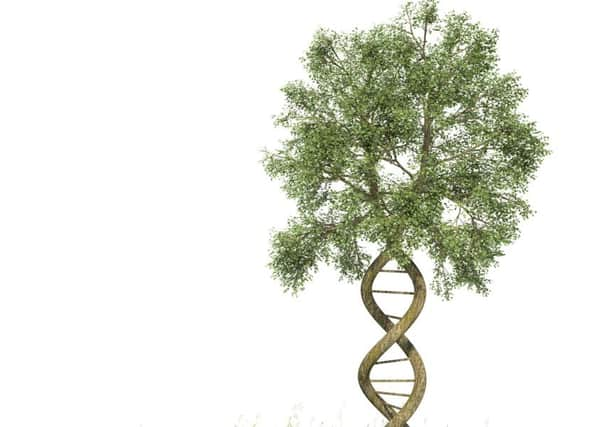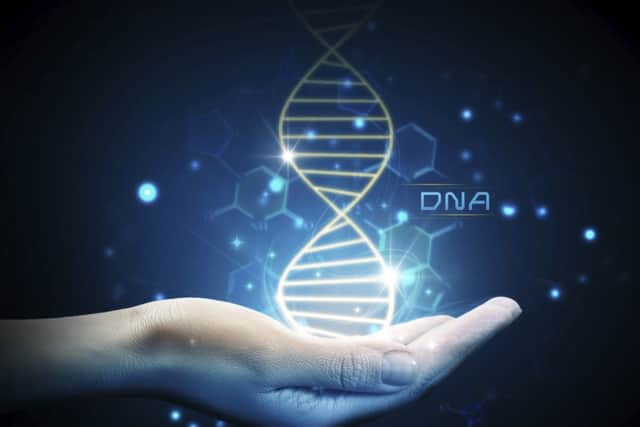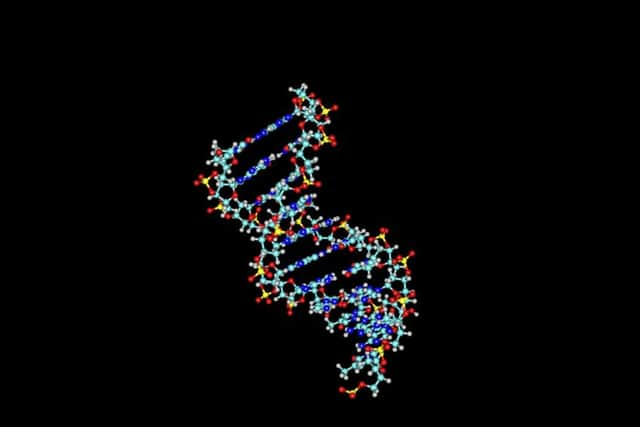Alistair Moffat: the DNA 70% of Scotsmen carry


As one of the oldest schools in continuous existence in Scotland, Inverness Royal Academy is used to being part of history and when work began on a larger site to the south of the city in late 1975, a new era began. And an ancient era was accidentally revealed.
Workmen leveling the ground near Culduthel Mains Farm skinned the lid off a stone cist and a pale winter light shone on a skeleton at least 4,000 years after it had been buried. As well as teaching history, Inverness Royal Academy was inadvertently making it. The cist-grave revealed a fascinating, epoch-changing period of Scotland’s history, one that was significantly better understood because of new data produced by ScotlandsDNA.
Advertisement
Hide AdAround the skeleton a group of objects, grave goods, were arranged and each had a tale to tell of our prehistory. Largest was a finely made bell-shaped pot known as a beaker. Thin-walled, beautifully turned and with its characteristic decoration added by pressing twisted cords into the clay while it was wet, the beaker was of a type first made in Portugal around the estuary of the wide River Tagus some time around 2,800BC. It seems that Inverness was the terminus of a long cultural migration from the southernmost ends of Europe.


The Scotsman reported on 25, November 1975.
Gold found in ‘most important archaeological discovery’
The Procurator Fiscal at Inverness is expected to investigate the discovery of human remains in a grave on the outskirts of Inverness - though they could be as much as 3500 years old.
The small bone burial cist, thought to be of the Scottish Bronze Age period, and possibly about 3500 years old, has revealed several artefacts, one of which includes a quantity of gold.


The square cist, uncovered at the weekend by contractors on a school building site at Culduthel, was first examined by police.
When it was found to be of ancient origin, the Assistant Curator of Inverness Museum, Mr Laurence Wedderburn, was called in.
“What we have found,” Mr Wedderburn said, “indicates that this cist is one of the most important and significant archaelogical finds of its kind in the Inverness area for a very long time. The discovery of gold in one of the artefacts makes it a matter of treasure trove, and I was obliged to inform the fiscal.”
Good condition


Advertisement
Hide AdMr Wedderburn removed three of the best-preserved stones forming the square cist. A skeleton was found and then items which enabled an approximate date for the burial to be set.
Mr Wedderburn said: One of the first things we found was a beaker pot. It was smashed by a contractor’s digger, but it is complete, and will be reconstructed.
Advertisement
Hide AdInside the beaker was a flint scraper and a bronze arm-bracer, used by archers to protect their arms from the bowstring.
“This bracer, which is in extraordinarily good condition, is mounted with four large gold relics which are about a quarter of an inch across their heads. In addition, the cist contained eight flint arrow heads of superior quality, a bone toggle, and a bead, which is possibly amber.
Last night the contents of the grave has been removed to Inverness Museum. Within the next few days the bronze and gold bracer and the beaker will be taken to the laboratory of the National Museum of Antiquities in Edinburgh for further inspection and preservative treatment.
What became known as the beaker package spread very quickly across Western Europe, far too quickly to be understood as a process of gradual adoption. T
he movement of the ability to make these fine pots and use them at the funerals of important people must have involved the movement of people over long distances. Ancestral DNA evidence adds important support. At a beaker cemetery at Kromsdorf in Germany, ancient DNA was extracted from two male skeletons and it turned out to be R1b, a Y chromosome super-cluster that is now found in very high frequencies in Northern and Western Europe.
In Scotland, our research has detected an overwhelming majority, a staggering 70 per cent of all Scotsmen carrying it. The crucial question is – why? What made the R1b men so successful that they outbred other lineages and became the ancestors of almost three quarters of all Scottish men? Important parts of an answer lay in the cist opened in Inverness in 1975 on a cold November day.
Advertisement
Hide AdNext to the beaker, archaeologists found eight expertly knapped and very sharp flint arrowheads, their wooden shafts having long since perished. And beside them was a bracer. Made from stone and set with four gold rivets, this was attached to the arm of an archer that held the bow and it prevented painful whiplash from the bowstring. Other beaker burials in Aberdeenshire and near Stonehenge also contain archery kit, and importantly, more substantial evidence of the coming of metalworking. There were copper daggers of great keenness and gold jewellery. A new people with dazzling new skills had arrived in Britain, an invasion clearly seen in the genetic as well as the archaeological record.
At ScotlandsDNA we have compiled the Great Tree of Mankind, a family tree of all men on Earth showing their descent from a single individual, the man known as Y chromosome Adam. He lived about 215,000 years ago. On a huge layout, we have shown how 573 Y chromosome sub-types descend from Adam. These include many newly discovered sub-types in Scotland and will be much augmented in the next few months. Uniquely, it also shows a hugely important historical turning point, what we believe is the enormous and immediate impact of the coming of the Beaker People.
Advertisement
Hide AdThe branches of the Tree immediately below Adam divide only very slowly over a long period of time. This is because he and his descendants were hunter-gatherers who probably lived in family bands and patrolled their ranges to find a wild harvest of roots, fruits, fungi and animals they could trap or bring down. Populations grew slowly.
But then the Great Tree abruptly changes. About 4,500 years ago, many new branches suddenly appear over a very short period. This is noticeable across the whole Tree but particularly clear under the very Scottish haplogroup, R1b S145, where a staggering 25 new branches are found. Only in Ireland is the percentage of men in this haplogroup higher than in Scotland. What this means is something simple yet very significant – many more children are being born and surviving to adulthood. The men born at this time created new sub-types in the Y chromosome Tree which then created more in a huge lateral expansion.
To view a section of the R1b on the Great Tree – please click on following link : https://www.scotlandsdna.com/download/the-great-tree-rib-section.pdf
This happened because of the greatest revolution in our history, the coming of farming and the increasing sophistication of its techniques. It had come to Britain before c2,500BC but new peoples clearly changed its practice in some way around that time. It may be that the Beaker People better understood how to grow grain.
This ability to cultivate cereals had a crucial impact. In early hunter gatherer societies, the diet of roots, fruits, berries, funghi, whatever animals could be trapped or killed and the rest of the wild harvest meant that soft infant teeth had difficulty coping with it. Until the age of four or five, the best source of class I protein for babies and toddlers was probably breast milk. This had a profound effect on these prehistoric societies. Because women are generally unable to conceive when they are nursing, that could mean a birth interval of four or five years and in a relatively short life, women gave birth to perhaps only three or four children, not all of whom would survive. Populations either replaced themselves or increased very little.
But when the first farmers began to grow grain such as primitive wheat or barley, the diet of toddlers changed. Instead of depending on breast milk, they could have a nourishing, high protein mash of grain mixed with water or animal milk spooned into their hungry mouths. What might be thought of as primitive porridge. And indeed, porridge changed the world. As more and more children were born to the beaker people after about 2,500BC, an exponential rise in population began as more children survived and begat more children.
Advertisement
Hide AdThe earlier farmers encountered by the beaker immigrants carried different genetic lineages, in particular the G haplogroups. Establishing farmland involved immense effort such as woodland clearance and the notion of ownership of land grew stronger. When the Beaker men arrived, almost certainly expert in archery, with sharp metal weapons and probably horse-riding skills, they began to take over and not only displace the earlier pioneers but probably also killed them. Or if they were displaced, they moved to poor land and did not thrive. The relatively low incidence of other Y chromosome lineages in Scotland compared to R1b certainly suggests radical population shift, violent or otherwise.
Given the approximate date of the arrival of the beaker people, and the likelihood that many of them came from the south, ultimately from the Iberian Peninsula, there is a strong case to be made that they brought Celtic languages to Britain. New and powerful incomers have often imposed their languages, and if ancient proto-Celtic described new techniques for farming as well as for the new skills of metal working and these came out of the mouths of the dominant beaker people, then its introduction may well have dated to c2,500BC. Modern Gaelic and Welsh have largely retained their characteristic sophistication in describing a pre-urban world. The range of detailed vocabulary available to describe the natural world is much greater than in English.
Advertisement
Hide AdIt is a hypothesis, but a very plausible one, that the cist at Culduthel is more than a simple grave, but rather, a memorial to a prehistoric takeover, perhaps even a genocide as the ancestors of 70% of Scotsmen seized land and began to multiply.